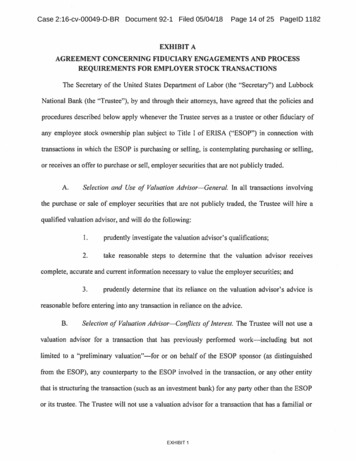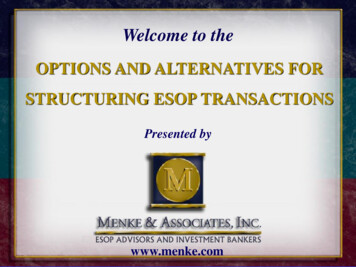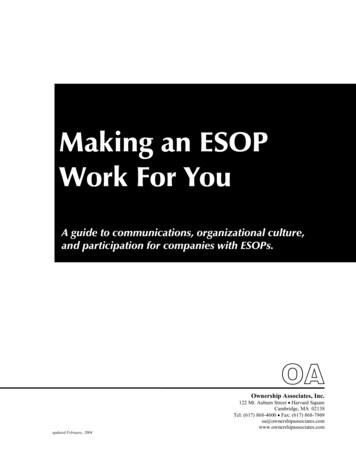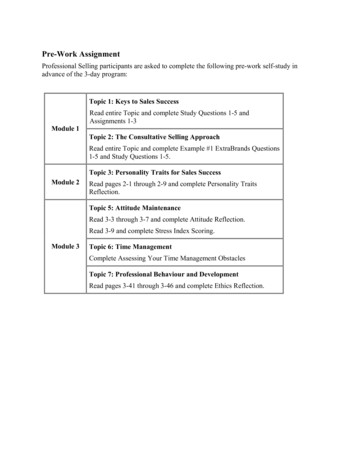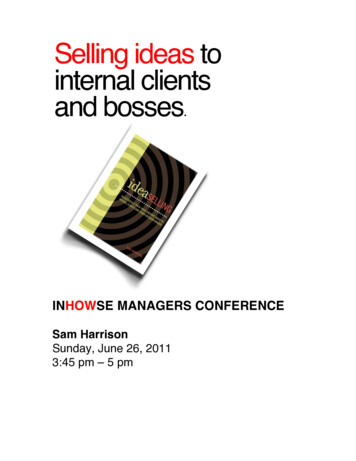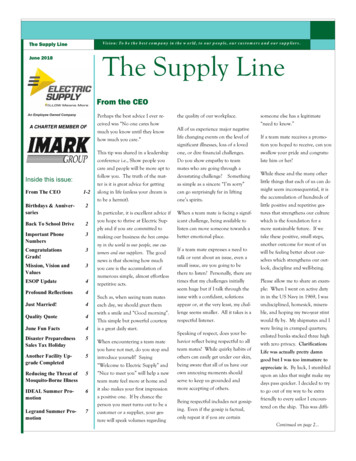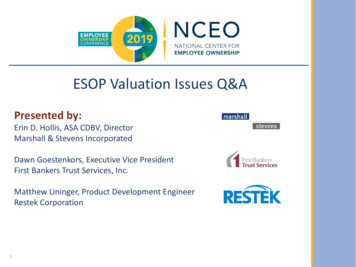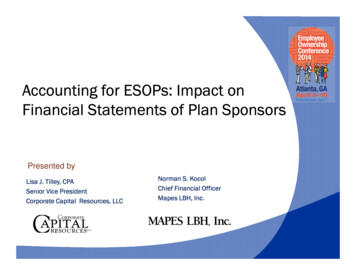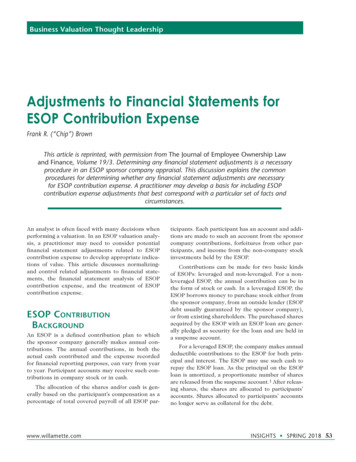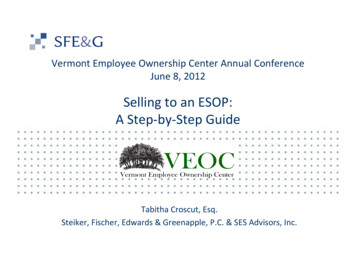
Transcription
Vermont Employee Ownership Center Annual ConferenceJune 8, 2012Selling to an ESOP:A Step-by-Step GuideTabitha Croscut, Esq.Steiker, Fischer, Edwards & Greenapple, P.C. & SES Advisors, Inc.1
Agenda Ownership Transition for Privately-Owned Companies Common ESOP Transaction Structure Examples C Corporation ESOPs S Corporation ESOPs2
Ownership Transitions for PrivatelyOwned Companies3
Liquidity and Succession:Some Common Goals Maximize after-tax proceeds Control timing of succession and transfer Shareholder/officer ongoing role as executive Diversify personal wealth Legacy4
Liquidity & SuccessionAlternativesExternal buyers– Strategic– Financial– IPOInternal Buyers––––FamilyManagementPartner (Redemptions & Buy-Sells)ESOPLiquidation5
ESOP Basics6
What is an ESOP? “Employee Stock Ownership Plan” Qualified retirement plan under IRC– Regulated by US DOL and IRS– Company funded benefit - no employee contributions– Assets held in a Trust; employees do NOT own the stockdirectly– Intended to be invested primarily in company stock Only qualified retirement plan that can borrow money Tax efficient and controlled means of selling stock7
Why Use An ESOP? Shareholder Liquidity: Create a market for part of the owners’ stock Shareholder Tax Minimization: Defer payment of capital gains taxes Corporate Tax Minimization:– Effectively create interest AND principal payments tax deductions– S corporation ESOP federal income tax exemption Succession Planning: Shareholders can sell shares while maintainingcontrol of the company Legacy: Maintain company’s independence Employees: Motivate, retain and reward employees8
Business OwnerObjectives? LegacyEmployee concern (family)Control / maintain day-to-dayDiversificationAvoid / Reduce Income Tax (Seller & Company)Control of deal structureAdditional retirement plan for employeesIncrease employee productivity / employee incentiveNot ready to golf / leave companyValue / purchase price certaintyNo ownership transition alternatives – close the doorsLiquidityRemove unwanted shareholders / reduce large number of shareholders9
ESOP’s Primary Roles Help owners convert paper wealth into cash and liquidity Help manage the succession/continuity of the business Reward the people that have helped grow the company Transition in a controlled and tax efficient manner10
ESOP Trust Ownership:Beneficial vs. Direct Ownership Shares purchased by the ESOP are owned in a trust, not byplan participants– Eligible employees are “beneficiaries” of the trust An independent trustee represents the interest of ESOPparticipants11
XYZ, Inc. lectBoard of Directorsappoint and overseePresident and CEOhires and overseesManagement Teamhire and overseeEmployees12
XYZ, Inc. StructureAfter ESOPShareholdersNon-ESOPShareholdersESOP Board of Directorsappoint and overseePresident and CEOhires and overseesESOPeligibilityrequirementsare metManagement Teamhires and overseesEmployees13
Common ESOPMisperceptions Participants own and vote the stock– Untrue unless you are a public company or shareholders get to voteon a major issues (which does not include voting for the Board) Participants are entitled to company financial statements– Untrue, unless you are a public company All of the company’s stock must be sold to an ESOP A company has to be a C corporation to sponsor an ESOP A company has to use debt to sell stock to an ESOP14
Situations Not Befittingan ESOP No successor management Owner only wants a few people to own the company There may not be enough “Es” to “SOP” Owner’s price is “opportunistic”15
Where Do You Start? Conferences like this are a good start.NCEO books and websitesAsk what do you want?What can work for you and your company?16
The Forming ESOP Process Consider a transaction study Creates the book for the Trustee Sets the transaction in motion.17
The Forming ESOP Process An ESOP Trust is establishedAn ESOP Trustee is appointed (Internal or External)An outside appraisal of the companyThe owners sell their stock to the Trustee and possibly theCompany The Trustee and the Company issues notes to the owners orowners receive cash The owners get an employment contract and non competeagreement18
Living the ESOP Every month the ESOP is paid down and the old owners get acheck At the end of each year:– A new appraisal is done on the company– Stock is distributed to eligible employees– Stock is distributed at original sale price but assumes new price inemployee account. A company meeting is held and everything is explained19
Some Common ESOPTransaction Examples20
Typical ESOP Transactions:Case Study Assumptions XYZ Corp. has two shareholders, Jim who owns 80% and Patowning 20% XYZ is profitable and has a payroll of approximately 8 million The company’s book value is 10 million Earnings (EBITDA) average approximately 3 million per year FMV is 15 million21
Case I: Non-LeveragedESOP Jim is seeking to sell his stock over several years as he approachesretirement XYZ Corp. would prefer to remain debt-freeSolution“Pay-as-you-go” ESOP22
Pay-as-You-Go ESOP 500,000 Cash ContributionXYZ Corp RESULT: Company contributes to ESOP each year basedon profits Here, ESOP buys 3.3% of XYZ Corp. from Jim,who will then own 76.7% Post transaction, Jim may be appointed Trusteeand votes the ESOP’s stock Jim can continue this stock sale strategy eachyear at his discretion subject to complying withfiduciary duties as Trustee. 500,000 CashESOP 3.3% ofXYZSharesJim(Taxable Transaction)23
Case II: Non-LeveragedESOP The company has just experienced several financially challenging years,but the company’s prospects are now much brighter Jim would prefer waiting to sell stock until the share price has improved Company wants to immediately reduce income taxesSolutionPre-Funding the ESOP24
Pre-Funding the ESOP 200,000Year 1XYZ CorpESOP 500,000Year 2 1,000,000 200,000 700,000 300,000Stock 1,000,000Year 3RESULT: Company receives tax deduction contributions eachyear, thereby reducing tax bill ESOP accumulates 1,000,000 ( ) of cash over threeyears Jim sells 6.7% of stock to ESOP after Year 3Jim(Taxable Transaction)XYZ Stock25
Case III: Partial LeveragedESOP Transaction Jim wishes to sell a large percentage, but not all, of his stock to the ESOP Jim does not want to pay capital gains taxes The company has “debt capacity”SolutionThe Partially Leveraged ESOP26
Partial Leveraged ESOP The ESOP purchases 33% of XYZ’s stock from Jim for 5 million The stock purchase is financed with a 5 million loan, which will be repaidover time27
Partially Leveraged ESOPBankXYZ Corp 5 Million Cash 5 Million Note Payable 5 Million Cash 5 Million Note Payable 5 Million CashESOPJim 33% of theOutstandingSharesXYZ Stock28
Paying Off The DebtBank Loan Repayment ( 500K)Annual ESOP Contribution s( 500K)XYZ ESOPTerm Loan Repayment 1. Company makes tax deductiblecontribution to the ESOP2. ESOP uses the contribution to repayits loan from company3. Company repays Financial Institution29
Case IV:100% ESOP Buyout Jim and Pat sell 100% of their XYZ stock to the EOSP for 15 million– The stock purchase is financed with a 7.5 million bank loan and 7.5 millionsubordinated seller note, with warrants Selected managers participate in a Management Incentive Plan that is tiedto the value of equity– This benefit is in addition to their ESOP participation30
100% Leveraged ESOPBank ESOP 15 Million Note Payable 15 Million CashXYZ Corp 15 Million Cash 7.5 Million Note Payable 7.5 Million “Day Loan” 15 Million Cash 100% of theOutstandingSharesJim & PatXYZ Stock31
100% Leveraged ESOPBankXYZ Corp 7.5 Million PaydownOfDay Loan 7.5SuSe borlle dinr N atot edesESOPMillionCashJim & PatXYZ Stock32
Paying Off The DebtBank Loan Repayment ( 500K)Annual ESOP Contribution s( 500K)XYZ ESOPTerm Loan Repayment 1. Company makes tax deductiblecontribution to the ESOP2. ESOP uses the contribution to repayits loan from company3. Company repays Financial Institution33
Paying Off The Debt Loan Repayment ( 500K)Annual ESOP Contribution s( 500K)XYZ ESOPNoteholdersJim & PatTerm Loan Repayment 1. Company makes tax deductiblecontribution to the ESOP2. ESOP uses the contribution to repayits loan from the company3. Company repays Sellers34
Seller Note Characteristics Seller notes yield between 19% and 14% depending on the market rates Part of the yield is made up of a “current pay”, or interest income The balance of the yield is made up of stock warrants, or a right to buystock at a certain price, for a certain period of time The amount of warrants is determined by the amount of interest incomeand the total targeted yield on the note35
Management IncentivePlans Key managers are awarded synthetic stock incentives This ownership is not direct ownership of stock, which limitscomplexity, but conveys economic value based on companyperformance Non-qualified plan that can be designed from “whole cloth” KEY: needs to be tied to increased equity value so ESOP is notoverly diluted Generally the value of these plans is 10-15% of the fullydiluted equity36
Results Jim & Pat have locked in their value at 15 million, having collected 7.5mm in cash at closing– Seller note warrants could bring in additional value– No capital gains taxes due (C corps only) Jim & Pat can remain employed as officers / employees if they wish Selected managers could have a claim on equity value through syntheticequity Employees will receive new retirement benefit that is tied to the successof the company The company has eliminated federal and (most) state corporate incometaxation37
C CorporationESOP Advantages38
Capital Gain Tax DeferralRules Company has to be a C corporation at time of transaction S corporations still can do ESOPs, but no capital gains taxbenefit (more on this later) ESOP’s ownership must be 30% to qualify for the capitalgains tax benefit (if ESOP owns less than 30%, capital gains taxwill be due) Seller must reinvest the proceeds in “Qualified ReplacementProperty” within 15 month window Stock sold must have a 3-year holding period39
Qualified ReplacementPropertyEligible*Not Eligible Common Stock Convertible Bonds Corporate FixedRate Bonds Corporate FloatingRate Notes (FRN) Municipal BondsU.S. Government BondsMutual FundsForeign SecuritiesREITsBank CDs*Eligible issuer must have:– Securities of a corporation that is incorporated in the U.S.– More than 50% of its assets used in the active conduct of a trade or business– No more than 25% of its gross income from passive sources40
Seller Capital Gain Tax Deferral:QRP Considerations Issue: If any QRP is sold, the pro rata deferred capital gainstax becomes due Implications:– The QRP portfolio cannot be actively managed– Minimize callable securities Solution: Purchase an “ESOP Bond”41
ESOP Bond Issued by AAA and AA credits Long term:– Typically a 50 year maturity– Non-callable for 30 years Floating rate interest paid quarterly using LIBOR42
Unlocking the QRP Lockup 5 MillionFrom ESOPStock Sale 5,000,000ESOPBond To Seller43
S CorporationESOP Advantage44
S Corporation ESOP TaxBenefits S corporation shareholders are responsible for paying their pro rata shareof the company’s tax liability An ESOP is a qualified, tax-exempt trust similar to a 401(k) trust As an S corporation shareholder, the ESOP is not required to pay its prorata share of the company’s taxes ESOP can use distributions it receives to pay debt rapidly This company is exempt from paying federal and most state income taxes45
S Corporation Distributionswith ESOPsIRSTaxPayment 300,000Distribution(60% Shareholder) 200,000Distribution S Corp generates taxableincome of 1,000,000 S Corp makes a 500,000distribution to itsshareholders pro-rata(40% Shareholder) 200,000Loan Pmt.AssumptionsESOPJimFIS Corp 200,000Loan Payment46
Do ESOPsReallyIncreaseEmployeeProductivity47
Best ESOP Candidates? Are profitable and growingCan finance their own growthAre not overleveragedHave good financial reportingHave a deep and broad management team48
Steps in ESOP Transaction Feasibility Study (Transaction Analysis)FinancingAppraisalPlan DesignLegal DocumentationClosingIRS Determination Letter49
Thank YouFor Your Time Today.Tabitha Croscut, Esq.ShareholderSteiker, Fischer, Edwards &Greenapple, P.C.SES Advisors, Inc.156 College Street, 3rd FloorBurlington, VT 05401(802) 860-4077 sors.com50
1 Vermont Employee Ownership Center Annual Conference June 8, 2012 Selling to an ESOP: A Step-by-Step Guide Tabitha Croscut, Esq. Steiker, Fischer, Edwards & Greenapple, P.C. & SES Advisors, Inc.
